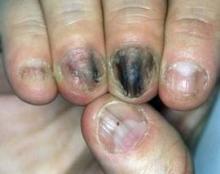LISBON – Applying a fast-drying cyanoacrylate glue to the proximal nail fold once or twice weekly is an inexpensive and effective treatment for the habit-tic condition of onychotillomania.
Onychotillomania is often categorized as a compulsive psychiatric disorder. The same psychiatric medications employed in cases of obsessive-compulsive disorder, including selective serotonin reuptake inhibitors, are sometimes prescribed to good effect.
Gluing the problem nail – it is most often a thumbnail – can work, and at negligible cost, with low risk, and no risk of systemic side effects stemming from psychiatric medications, Dr. Veronique Blatiere said at the annual congress of the European Academy of Dermatology and Venereology.
The likely mechanisms of benefit from the cyanoacrylate glue, such as Super Glue or Krazy Glue, are twofold: the built-up layer of glue creates a physical barrier that helps protect the proximal nail fold against the patient’s mindless repetitive picking, and, at the same time, the artificial layer promotes self-awareness of the tic habit, said Dr. Blatiere, a dermatologist at the University of Montpellier (France).
She credited the instant nail-gluing therapy to Dr. Daniel S. Ring, a Chesterfield, Mo., dermatologist who presented the approach in the Archives of Dermatology (2010;146:1222-3).
Dr. Ring described onychotillomania as a common condition given little attention in most dermatologic textbooks. Onset is typically in adulthood, and patients frequently bring up the problem as an "oh, by the way" afterthought during an office visit scheduled for another reason.
Patients typically display parallel transverse ridges running from the proximal nail fold to the distal nail plate along with a lack of cuticle. These changes result from years of picking at the cuticle or pushing it back.
In his report, Dr. Ring described two cases in detail and mentioned 10 others successfully treated with glue. The affected nails typically normalized after 3-6 months of weekly gluing.
Dr. Blatiere said that instant-drying cyanoacrylate glues may also be worth investigating for the treatment of chronic paronychia.
However, she noted that a potential hazard of applying this therapy for months at a time is development of an allergic contact dermatitis to the acrylate.
Neither Dr. Ring nor Dr. Blatiere reported having any financial conflicts.


